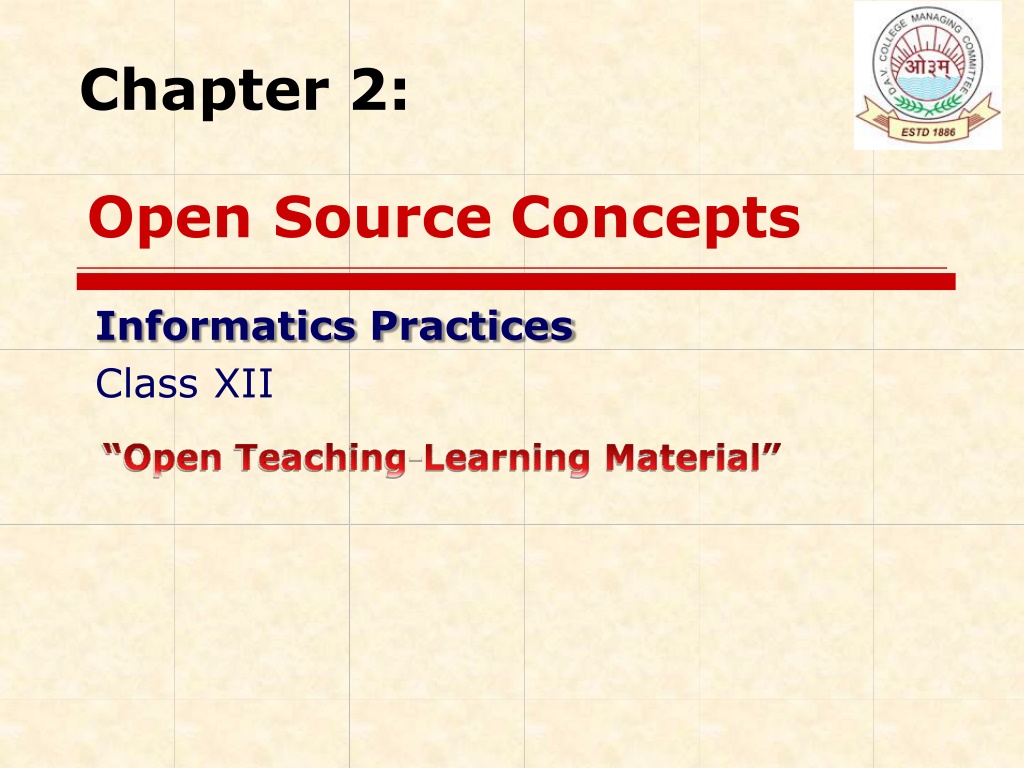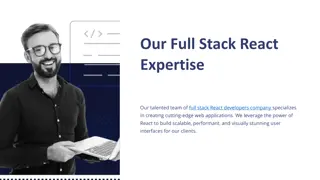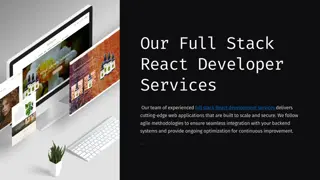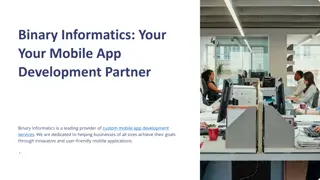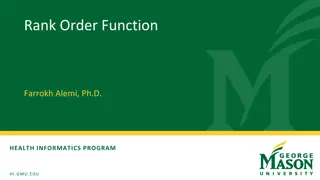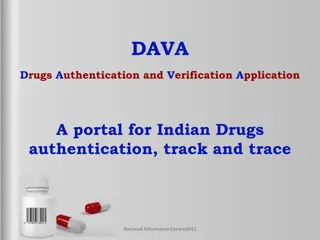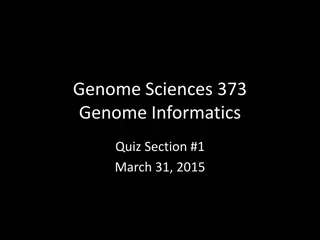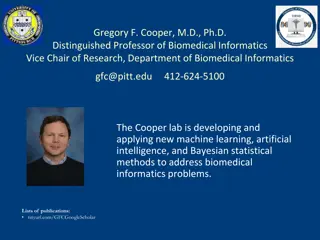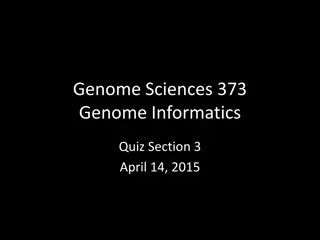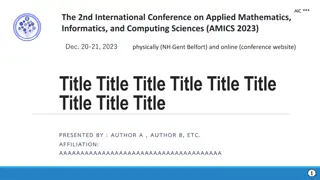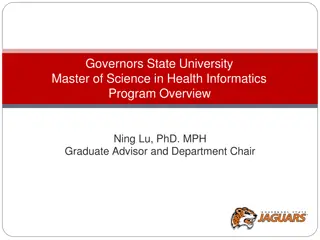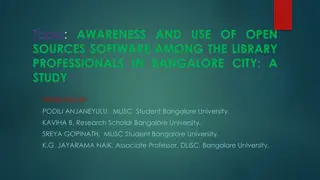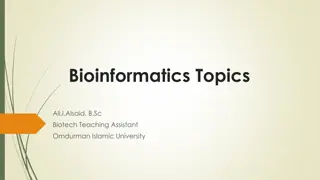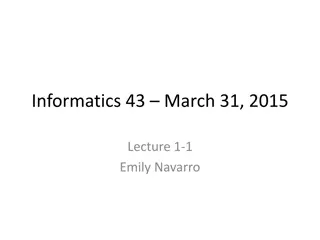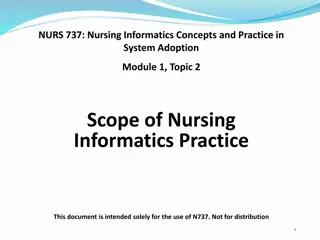Open Source Concepts in Informatics Practices
You will delve into the world of open source software, understanding its principles, differences from proprietary software, and discovering organizations like GNU involved in promoting open source ideals. Explore the freedoms, benefits, and characteristics of open source and free software, paving the way for a deeper insight into the realm of OSS and its significance in the field of informatics practices.
Download Presentation

Please find below an Image/Link to download the presentation.
The content on the website is provided AS IS for your information and personal use only. It may not be sold, licensed, or shared on other websites without obtaining consent from the author.If you encounter any issues during the download, it is possible that the publisher has removed the file from their server.
You are allowed to download the files provided on this website for personal or commercial use, subject to the condition that they are used lawfully. All files are the property of their respective owners.
The content on the website is provided AS IS for your information and personal use only. It may not be sold, licensed, or shared on other websites without obtaining consent from the author.
E N D
Presentation Transcript
Chapter 2: Open Source Concepts Informatics Practices Class XII
Introduction You all have worked on various types of Software of different category- Operating System (Windows XP, Windows 7 etc.) Office Suits (MS Office, Lotus etc.) Computer Games Software etc. You can not change their features because they all are Proprietary Software i.e. they are intellectual property of any developer or organization and source code is also not given. But some Software comes with their source code and allow us to make any type of change without taking permission of the developer .. Since you are already licensed to do this. These category of software are called Open Source Software (OSS).
Free Software Free Software are those which are freely accessible, freely used, changed, improved, copied and distributed. It provides all types of freedom. Free means Freedom at very little or No cost. Source Code is also available with Free Software. As per definition given by Richard Stallman of Free Software Foundation, Free Software should have the following freedom- Freedom 0: Run the program for any purpose. Freedom 1: Study and change the program as per need. Freedom 2: Redistribute copies to others. Freedom 3: Improve the program and release new version for community benefits. Later on, the term Free Software is known as Free/Liberal Open Source Software (FLOSS) or FOSS.
Open Source Software (OSS) Open Source Software can be freely used, changed, improved, copied and Redistributed but it may have some cost for the media and support for further development. Source Code is also available with OSS. It can be modified and redistributed with some guidelines of the License called GPL (General Public License). The License may restrict distributed and modification to maintain the Author s integrity. Any change requires different code name and version number from the Licensing organization or Developer. A software which is FREE as well as OPEN, called Free & Open Source Software (FOSS) or Free Libre & Open Source Software (FLOSS). source-code from being
Other Categories of Software Proprietary Software: These Software are neither open nor freely available. They must have some cost and Source code is also not given since it is property of the developer organization. No change, copy and distribution is allowed. Freeware: These are available free of cost. They can be used, copied, distributed but because Source Code is not available. Shareware: These software are freely used, copied and distributed for a certain period of time. After expiry, you have to purchase or uninstall them. Modification is not possible due to non-availability of the source code. These are the Demo version and freely distributed for trial purpose. no modification is allowed
Organizations involved in OSS GNU (GNU s Not Unix): GNU Project was initiated by Richard M. Stallman, with an aim to develop an OS like UNIX. Later, it is extended to develop wide range of software apart from Operating System. GNU offers a special type of License called GNU-GPL (General Public License) which gives guarantee that any software developed within GNU project would be free and available to everyone to use. Free Software Foundation (FSF): FSF is a non-profit organization established to support free software movement. It has funded many software developers to develop free software under GNU-GPL. It was founded by Richard Stallman in 1985 to support GNU project. Open Source Initiative (OSI): OSI was founded by Bruce Perens and Eric Raymond in 1986 to promote Open Source Software. It specifies the criteria and defines the terms and specifications for Open Source Software. World Wide Web Consortium (W3C): W3C was founded in 1994, to develop common protocols and software standards for the World Wide Web (WWW). The W3C is an International organization that promote specifications and reference software forWWW.
Examples of OSS/Free Software Operating Systems: Linux , Ubuntu , Android Smart Phone OS by Google, Symbian- Smart Phone OS by Nokia Graphics & Multimedia: GIMP (Photo Editor S/w like Photoshop) , Blender (3D Modeling S/w), Songbird (iTune S/w), Audacity (Audio Editor and Mixer), F-Spot (Photo Manager) Office Software OpenOffice.org (Office Suite like MS Office) , PDF Creator Internet Related S/w Apache Web Server Mozila Firefox, Google Chrome (web Browser) Mozila Thunderbird (e-mail client) Programming Language & Development tool: NetBeans, Eclipse (Java IDE), MySQL (Database Management S/w) PHP, PERL, PYTHON, JAVA (Programming Languages) Others: Celestia (3D Space Simulator software) Wine (tool to run Windows based Software on Linux)
Examples of OSS/Free Software GNU/Linux: Linux is Free & Open Source Operating System software. It is available with source code so that any one can use, modify and redistribute it. Originally it was developed by a Finnish University student Linus Torvalds in 1991. It comes in many flavors (editions) and is member of LAMP (Linux, Apache, MySQL, PHP/Python) group. It can be downloaded from www.linux.org Apache: Apache is Open Source Web Server available for many OS platforms like Linux, Unix, Windows etc. It is developed by an open community of developers under the umbrella of Apache Software Foundation. It also a member of LAMP group and can be downloaded from www.apache.org MySQL: MySQL is most popular open source Relational Database System. It is muti-user, SQL based RDBMS developed under GNU-GPL. It works on many platforms like Linux, Mac, OS/2, Sun OS and MS Windows etc. and supports many programming languages such as C, C++, Java, Perl, PHP and Ruby etc. It is also part of LAMP and can be downloaded from www.mysql.com
Examples of OSS/Free Software PHP: PHP stands for Hypertext Preprocessor. It is widely used open source Web programming language to develop Dynamic web content and Server-side applications. PHP is similar to MS ASP/VB Script/JAVA Script and CGI/Perl languages. PHP allows compatibility with a large number of RDBMS like MySQL, Oracle, DB2 etc. and run on most of the OS including Linux, Unix, Windows and Mac. It is also a member of LAMP group and can be downloaded from www.php.net Mozilla: Mozilla is free and very popular Web Application suit, originally developed by Netscape Communications Corporation. Now days, it is promoted by Mozilla Foundation. It includes various applications like- 1. Web Browser (Fire Fox) 3. IRC (Internet Relay Chat) client Mozilla s Firefox is very popular web browser and can be downloaded from www.mozilla.org PostgreSQL: PostgreSQL is free Object Oriented database Server under the BSD-style License. It is alternative to Open source MySQL and works like Orcle, MS SQL Server and Sybase etc. it can be downloaded from www.postgresql.org 2. E-mail Client (Thunder Bird) 4. HTML Editor
Examples of OSS/Free Software Python: Python created Foundation. It is compatible with Windows, Mac, Linux and Unix etc. Tomcat: Tomcat is a collection of Server-side developed under Apache Foundation. It can run independently or with any other web server to provide various functionalities like User authentication and security. It is bundled with Apache Server. Java & NetBeans: Java is open and platform independent programming language, most suited for developing web-based applications. It is developed by James Gosling at Sun Microsystems. NetBeans is an open IDE for writing and testing Java applications. Bharat Operating System Solutions(BOSS): BOSS is free Windows like Indian developed by C-DAC and is available in various Indian Languages. is by open-source Guido Van Cross-platform Rossum in 1990 programming for Python language Software Applications (Servlet) OS based on GNU/Linux
Examples of OSS/Free Software OpenOffice: OpenOffice or OpenOffice.org (OOo) is free office application suit like MS Office, developed under GPL and is available for MS Windows, Mac and UNIX-like OS. OOo is based on StarOffice and made open source by Sun Microsystems. It is similar to MS Office software. OOo Includes various components- Write ( like MS Word) Calc (like MS Excel) Impress (like Power point) Database (like MS Access) HTML Editor (like MS Front Page) Draw (Graphics Program like MS Paint) Math (Mathematical Formula Editor) OpenOffice can be freely downloaded from www.openoffice.org
Software Standards Software Standard refers the structural specifications which are followed by the developers, organizations and vendors. There are two types of software standards Proprietary Standard Standards belong to an organization or individual. Open Standard Standards open to all at free of cost.
Proprietary Standard Proprietary standard are those standards which belong to a company or person. Their specification are available to users with restricted license. They can not be publicly used and user have to bye license to use them. Ex: Microsoft Office format (.doc, .docx, .ppt, .xls etc.) Limitations of Proprietary Standard: Platform Dependent: If a file created in MS-Word, is transported to other user then recipient must have MS-Word to open it. Accessibility of confidential Information: A file may contains private information during transfer, since specification is not clearly stated. Single ownership or control: Proprietary standard belongs to a company or venders, so other user can not add/enhance its functionality and usefulness due to limited terms and conditions listed in the license.
Open Standard Open standard is open to all i.e. It is publicly and freely available without any restrictions to user. Advantages of Open Standard: Availability: It is freely available for all to read and implement without any royalty or fees. Platform Independent: It gives freedom to user for choosing their platform. It does not lock the customer to use particular application by particular vendor. The user can choose any software of their choice to open a file. No Discrimination: It does not favour any developer over another. No hidden Information: The Open license require the publication of reference information for extensions and license for all developers to create, distribute and sell software that is compatible with extensions. It is completely transparent, so no fear of loosing private information.
Commonly used Open Standard Plain Text (.ASCII) - Plain text i.e. Text without formatting. Hyper Text Markup Language (.HTML): It is standard language for the web page. It is flexible, universal format and can be read through any web browser program. XML: eXtensible Markup Language language which allows to create application specific structured documents. It is Open, portable, extensible language, mostly used for Internet based applications. Joint Photo Expert Group (JPEG or .jpg): It is one of the most efficient still picture compression format. It is open and very light format. It also allows you to determine the rate of data compression. Portable Network Graphics (.png): PNG is open and license free image format, alternative to .GIF. Generally it is used to display or transport images on Internet /web applications. It allow data compression without loss of information. (XML) is a text-based mark-up platform independent and
Commonly used Open Standard Ogg Vorbis (.ogg) It is new Audio compression format developed by Xiph.org as alternative to .mp3,.vqf and .wma etc. It is free, open and unpatented standard used to store and play digital music. Ogg is the name of container format for the Audio/Vidio and Vorbis compression scheme that is part of .ogg format. WWW World Wide Web (WWW) is open standard protocol used in Internet. It describes the communication model and o TCP/IP Transmission Control Protocol/Internet Protocol (TCP/IP) is widely used Open Standard Networking Protocol used to form Computer Network ranging from LAN to Internet. It is five layer communication model followed by the computers when connected to a Network. is name of specific Audio
Commonly used Open Standard Open Document Format (ODF) ODF is an XML based, open and free file format for representing and storing electronic documents such as document, spreadsheet etc. It was developed by OASIS (Organization for Advancement of Structural Information Standard) and approved by ISO. It is default file format for the application like OpenOffice, StarOffice and IBM s Workspace. It is also supported by some proprietary software like MS Office2007. The common ODF extensions are- .odt (Text document) .ods (Spread sheet document) .odp (Presentation document) .odg (Graphics file) .odb (Database file)
Indian Language Computing How Indian Languages scripts are implemented in computers?
Indian Language Computing It refers to ability to interact in diverse Indian Languages on Electronic system. As per 1951 census, 845 language were identified, out of which 60 were spoken by at least 100,000 people. Indian Constitution notifies 22 language of which 6 language (Hindi, Telgu, Tamil, Bengali, Marathi and Gujrati) are spoken by at least 50 million people. To facilitate ICT usage for rural people of India, Ministry of Communication & Information Technology, Govt. of India, provided software to promote Indian Languages.
How Characters are represented? ASCII (American Standard Code for Information Interchange) It is widely used Alphanumeric code system and universally accepted for the computers. It is 7-bit code and comprises 128 characters to represent standard keyboard characters (26 Small and Capital letters of alphabets, 10 digits and 7 punctuation marks) and various control characters. ISCII (Indian Standard Code for Information Interchange) In 1991, the Burou of Indian Standard adapted the ISCII. It is 8- bit code with 256 characters, which refers 128 characters of ASCII and rest 128 characters for Indian Scripts. ISCII has been used by IBM, Apple and other vendors for developing their products for Indian Society. It is widely used by Indian Government Departments (e.g. NIC, Election Commission etc.) for their various IT projects. This standard supports Devnagari (Hindi), Gurumukhi, Gujrati, Oriya, Bengali, Assamese, Telgu, Kannada, Malyalam and Tamil Script.
How Characters are represented? UNICODE It is universal coding standard developed by Universal Consortium in 1991 and adopted by all the leader organizations like Apple, HP, IBM, Microsoft, SAP, Oracle and Sun etc. as a computing platform for their software applications. It is 2-Byte code which represents country encoding and characters of their scripts. Unicode supports Indian Scripts including Devnagri, Bengali, Gurumukhi, Gujrati, Oriya, Tamil, Telgu, Kannada and Malyalametc. The advantages of Unicode are- Unicode enables a single Software product or Web site as to be multiple platform for different countries languages without redesigning it. It allow data to be transported through many different systems without any incompatibility. Unicode is supported by most of the OS and Applications.
What is Font? Fonts refers to set of displayable text characters (glyphs) having specific style and size. Basically a font is the resource file for displaying or printing characters of different language script on screen or printer. Various category of fonts are- Post Scripts Font developed by Adobe. True Type Font Developed by Apple and Microsoft. Open Type Developed by Open Source Community
Types of Font As per Technical specification, Fonts are classified as- True Type Fonts (TTF) TTF are developed by Apple and Microsoft. It is 8-bit structure widely used in Windows and Mac OS. It is easily manageable file which stores all the concerned information for previewing and printing text. It is not cross platform i.e. not suitable for older version of printers. Open Type Fonts (OTF) The OTF are extension of TTF and implemented in 16-bit. They allow a large glyph set using Unicode encoding. OTF contains data in table format along with glyph set. It can supports 65536 glyphs with Multi-lingual capability within one format. It is easily manageable, cross platform and easy to read and offers better quality. Not all the application supports the extended features.
Types of Font As per configuration, Fonts are classified as- Static Fonts The characters are designed and digitized, and then stored in a font file. Every time when printing takes place the same characters will appear with same shape. Times New Roman, Arial, Courier etc. are static font. Dynamic Fonts The character are redefined at each occurrence rather than static appearance. All the hand written font such as Calligraphic letters etc. belongs to this category, because each time when they are generated, font shape may differ to previous one.
Indian Language Text Entry Many software tools has been developed to facilitate the typing of Indian Language Text. They support two types of entry- Phonetic Text Entry In Phonetic Entry, the traditional QWERTY keyboard (English) is used but Indian alphabets are written phonetically i.e. the way they sound. The combination of keys are used to represent more characters. By transliteration (e.g. Google Hindi Input S/w), you can type Indian Words in English script and tool will automatically convert it corresponding language words. It is supported by many search engines, Social Networking site (Orkut, facebook etc.) and many websites (Blogger, Gmail etc.). Bhartiya OOo is also widely used for phonetic text typing. Key Map Based Entry In Key map entry, mapping of keyboard s key to character is arranges so that key map represents to Indian Language Set. Indian Language Key map or Inscript Key map is implemented by a Key map table containing all the information regarding translation.
